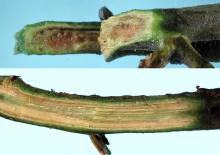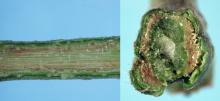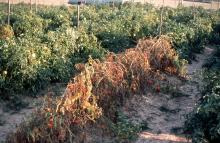See:
Tomato (Solanum lycopersicum)- Fusarium Crown and Root Rot
Tomato (Solanum lycopersicum) - Varietal Resistance
Tomato (Solanum lycopersicum) - Verticillium Wilt
Cause Fusarium oxysporum f. sp. lycopersici, a fungus that can survive several years in soil and is favored by warmer weather (84°F), high levels of phosphorus or certain micronutrients, and ammonium nitrogen. Tomato seed has been reported to sometimes be contaminated with this pathogen, including Fol race 3. This fungus can be spread by infested equipment, transplants, and windborne or waterborne infested soil. This fungus has been recovered from wooden stakes used with field-grown tomato. Shore flies (Scatella stagnalis) have been reported to transmit this fungus to healthy plants if diseased plants are nearby. Although this fungus causes disease specifically on tomato and other members of the tomato family, it may colonize the roots of nonhosts in the absence of any symptoms; it has been reported on Amaranthus, Chenopodium, Digitaria, Malva, and Oryzopsis spp. in other countries.
The fungus that affects tomato, Fusarium oxysporum f. sp. lycopersici, is in constant genetic evolution. For each Fusarium-resistant tomato variety developed, there is risk for selection of a new race of this fungus that will overcome the new plant resistance genes. At this point in time, there are several races of the fungus. Races 1 and 2 have been reported across the US. Race 3 causes more severe impacts on tomato and is becoming a widespread problem in California tomato production. Fol race 3 will likely occur elsewhere in the near future, including the PNW. Tomato varieties are available with resistance to one or more multiple races, but resistance doesn't denote absolute immunity. If soilborne populations of a race of Fusarium are high enough, tomato varieties with resistance to that fungal race can show some susceptibility and develop symptoms. Additionally, that are suggestions that resistance in some varieties may break down under certain environmental stresses.
Symptoms Lower leaves yellow, mostly on one side. Plants wilt during the hot part of the day but recover in the evening. Eventually the leaves remain wilted, shrivel, turn brown, and die. The vascular system discolors. Growth is retarded, and yields are low. Can be mistake for Verticillium wilt. Damping-off of young seedlings may be observed.
Cultural control
- Use resistant varieties or resistant rootstock if grafting.
- Remove and destroy all affected plant tissue, including roots.
- Thoroughly clean propagation equipment, especially if reusing plant trays and pots.
- Clean soil from equipment including machinery, tools, footwear, gloves, etc., after working in an affected planting.
- Manage for shore flies inside greenhouses, especially if propagating tomato.
- Rotating out of tomatoes 4 to 6 years may reduce losses.
Chemical control
- OSO 5% SC (Group 19) at 3.75 to 13 fl oz/A on 7- to 14-day intervals. Can be applied the day of harvest. 4-hr reentry. O
- Regalia (Group P5) at 1 to 3 quarts/100 gal water for soil drench or in-furrow spray applications on 10- to 14-day intervals. Does not benefit from the addition of an adjuvant. 4-hr reentry. O
Biological control
- Bexfond at 7 to 28 fl oz/A. 4-hr reentry. O
- Stargus at 6 to 8 fl oz per 1,000 ft row as an in-furrow treatment, or 3 to 4 quarts/A as a soil drench (drip or chemigation) on 10- to 21-day intervals. Preharvest interval is 0 days. 4-hr reentry. O
Reference McGovern, R.J. 2015. Management of tomato diseases caused by Fusarium oxysporum. Crop Protection 73:78-92.




